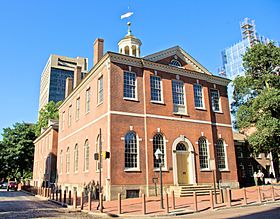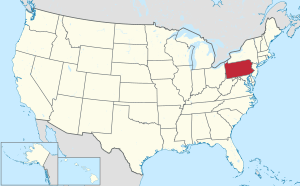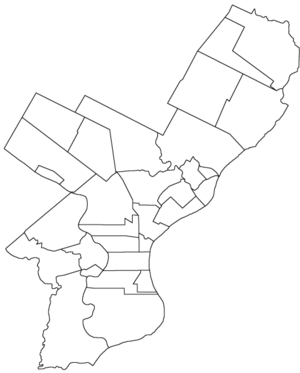Philadelphia County, Pennsylvania facts for kids
Quick facts for kids
Philadelphia County
|
|||
|---|---|---|---|
|
Consolidated city-county
|
|||
| City and County of Philadelphia | |||

Old City Hall in Philadelphia in June 2011
|
|||
|
|||

Location within the U.S. state of Pennsylvania
|
|||
 Pennsylvania's location within the U.S. |
|||
| Country | |||
| State | |||
| Founded | March 10, 1682 | ||
| Named for | City of Philadelphia | ||
| Seat | Philadelphia | ||
| Largest city | Philadelphia | ||
| Area | |||
| • Total | 143 sq mi (370 km2) | ||
| • Land | 134 sq mi (350 km2) | ||
| • Water | 8.6 sq mi (22 km2) 6.0%% | ||
| Population
(2020)
|
|||
| • Total | 1,603,797 | ||
| • Density | 11,969/sq mi (4,621/km2) | ||
| Time zone | UTC−5 (Eastern) | ||
| • Summer (DST) | UTC−4 (EDT) | ||
| Congressional districts | 2nd, 3rd, 5th | ||
Philadelphia County is the most populated of the 67 counties in Pennsylvania. It is also one of the most populated counties in the entire United States. In 2020, about 1,603,797 people lived there.
Philadelphia County covers the same area as the city of Philadelphia. Philadelphia is the sixth-largest city in the country. The county is located in the southeastern part of Pennsylvania.
Philadelphia County is one of the first three counties created by William Penn in November 1682. Since 1854, Philadelphia County has been the same area as the City of Philadelphia. The city is also its main government center. Philadelphia County is a very important place for business and culture in the Delaware Valley. It is one of the largest city areas in the country.
Contents
History of Philadelphia County
The first people known to live in the area that became Philadelphia County were Native American tribes called Lenape. The first European settlers were from Sweden and Finland. They arrived in 1638. The Netherlands took control in 1655, but England took it over in 1674.
King Charles II of England gave William Penn a special document (a charter) for Pennsylvania in 1681. In November 1682, Penn divided Pennsylvania into three counties. In the same year, Philadelphia was planned. It became the main government center and capital of the Pennsylvania colony.
Penn wanted Philadelphia to be a place of "brotherly love." He wanted everyone to have religious tolerance and freedom to worship. The city's name is shared with an ancient city in Asia Minor mentioned in the Bible. Penn, who was a Quaker, hoped his "Holy Experiment" would be a good example for the world.
When it was first created, Philadelphia County stretched from the Delaware River west. It was between the Schuylkill River to the south and the border with Bucks County to the north. Its western border was not clearly defined. Over time, two new counties were formed from parts of Philadelphia County. These were Berks County in 1752 and Montgomery County in 1784. These changes helped create the county's current borders.
The original city of Philadelphia, as planned by Penn, was only a small part of the city we know today. It was located between South and Vine Streets and the Delaware and Schuylkill Rivers. Other towns and settlements grew up outside these city limits. Over time, they became separate towns with their own governments.
Many of these towns were right next to the City of Philadelphia. Examples include Southwark and Moyamensing to the south, and Northern Liberties and Kensington to the north. West Philadelphia was to the west. Together, these areas formed one big urban area, often just called Philadelphia.
There were also many other smaller towns and villages throughout the county. As more people moved to the area, the towns closer to Philadelphia became part of the city.
During this time, the city government of Philadelphia and the county government acted separately. By the mid-1800s, a more organized government was needed. A new law in 1854 combined all the towns, townships, and districts of Philadelphia County into the City of Philadelphia. This ended the old system of many small governments.
This combining of the city and county was needed because the old government was not able to handle the needs of a growing city. People needed better streets, police, transportation, sanitation, and schools.
The newly combined areas had their own unique features. But after the consolidation, these features slowly blended into the City of Philadelphia. Today, the names of some of these old districts are still used as neighborhood names in the city. Their borders are similar to the old historic boundaries.
In 1951, a new law called the Home Rule Charter completely merged city and county offices. This new charter gave the city a single structure. It also created the "strong mayor" form of government that is still used today.
The county offices officially merged with the city government in 1952. This meant the county no longer had its own separate government. However, Philadelphia County is still recognized as a county within Pennsylvania by law. It follows state laws for counties, with some exceptions due to its unique city-county merger. It is also the only "First Class County" in Pennsylvania. This means it had a population of 1.5 million or more at the last census.
Philadelphia has become very diverse over the years. Since 1990, many immigrants from Latin America, Asia, and Europe have moved to the county. Today, the city has large populations of people with Irish, Italian, German, Polish, Puerto Rican, Korean, Vietnamese, Russian, Ukrainian, Jamaican, Chinese, Arab, Thai, and Cambodian backgrounds. It also has the fourth-largest number of African Americans in North America. This includes many people from Liberia, Nigeria, and Sudan. The Northeast part of the city and its suburbs have many people from India and Mexico.
In 2010, the city's population was 41.0% White, 43.4% Black or African American, and 6.3% Asian. About 12.3% of the population was Hispanic or Latino.
Geography of Philadelphia County
Philadelphia County has a total area of about 143 square miles. Most of this is land (134 square miles), and about 8.6 square miles (6.0%) is water. It is the second-smallest county in Pennsylvania by area. Important bodies of water include the Delaware River, Schuylkill River, Cobbs Creek, Wissahickon Creek, and Pennypack Creek.
The lowest point in the county is 10 feet above sea level. This is near Fort Mifflin in Southwest Philadelphia, where the Delaware and Schuylkill Rivers meet. The highest point is in Chestnut Hill, at 432 feet above sea level. This is near Evergreen Place.
Neighboring Counties
- Bucks County (northeast)
- Burlington County, New Jersey (east)
- Camden County, New Jersey (southeast)
- Gloucester County, New Jersey (south)
- Delaware County (southwest)
- Montgomery County (northwest)
Main Roads and Highways
Population Changes Over Time
| Historical population | |||
|---|---|---|---|
| Census | Pop. | %± | |
| 1790 | 54,391 | — | |
| 1800 | 81,009 | 48.9% | |
| 1810 | 111,210 | 37.3% | |
| 1820 | 137,097 | 23.3% | |
| 1830 | 188,797 | 37.7% | |
| 1840 | 258,037 | 36.7% | |
| 1850 | 408,762 | 58.4% | |
| 1860 | 565,529 | 38.4% | |
| 1870 | 674,022 | 19.2% | |
| 1880 | 847,170 | 25.7% | |
| 1890 | 1,046,964 | 23.6% | |
| 1900 | 1,293,697 | 23.6% | |
| 1910 | 1,549,008 | 19.7% | |
| 1920 | 1,823,779 | 17.7% | |
| 1930 | 1,950,961 | 7.0% | |
| 1940 | 1,931,334 | −1.0% | |
| 1950 | 2,071,605 | 7.3% | |
| 1960 | 2,002,512 | −3.3% | |
| 1970 | 1,948,609 | −2.7% | |
| 1980 | 1,688,609 | −13.3% | |
| 1990 | 1,585,577 | −6.1% | |
| 2000 | 1,517,550 | −4.3% | |
| 2010 | 1,526,006 | 0.6% | |
| 2020 | 1,603,797 | 5.1% | |
| U.S. Decennial Census 1790–1960 1900–1990 1990–2000 2010–2019 2020 census |
|||
In 2000, there were 1,517,550 people living in Philadelphia County. There were 590,071 households and 352,272 families. The population density was about 11,233 people per square mile.
The racial makeup of the county in 2000 was:
- 45.0% White
- 43.2% African American
- 5.5% Asian
- 0.3% Native American
- 0.1% Pacific Islander
- 5.8% from other races
- 2.2% from two or more races
About 8.5% of the population was Hispanic or Latino. The largest ancestry groups included Irish (13.6%), Italian (9.2%), German (8.1%), Polish (4.3%), and English (2.9%).
About 27.6% of households had children under 18. About 32.1% were married couples. The average household had 2.48 people, and the average family had 3.22 people.
About 25.3% of the population was under 18. About 14.1% were 65 or older. The average age was 34 years. The median household income was $30,746. About 22.9% of the population lived below the poverty line.
2020 Census Information
| Race / Ethnicity (NH = Non-Hispanic) | Pop 2000 | Pop 2010 | Pop 2020 | % 2000 | % 2010 | % 2020 |
|---|---|---|---|---|---|---|
| White alone (NH) | 644,395 | 562,585 | 550,828 | 42.46% | 36.87% | 34.35% |
| Black or African American alone (NH) | 646,123 | 644,287 | 613,835 | 42.58% | 42.22% | 38.27% |
| Native American or Alaska Native alone (NH) | 2,908 | 3,498 | 2,596 | 0.19% | 0.23% | 0.16% |
| Asian alone (NH) | 67,119 | 95,521 | 132,408 | 4.42% | 6.26% | 8.26% |
| Pacific Islander alone (NH) | 495 | 457 | 579 | 0.03% | 0.03% | 0.04% |
| Other race alone (NH) | 2,856 | 4,105 | 11,419 | 0.19% | 0.27% | 0.71% |
| Mixed race or Multiracial (NH) | 24,726 | 27,942 | 53,855 | 1.63% | 1.83% | 3.36% |
| Hispanic or Latino (any race) | 128,928 | 187,611 | 238,277 | 8.50% | 12.29% | 14.86% |
| Total | 1,517,550 | 1,526,006 | 1,603,797 | 100.00% | 100.00% | 100.00% |
Neighborhoods of Philadelphia
The City of Philadelphia is made up of many different neighborhoods. Before 1854, these neighborhoods were often separate towns or districts.
Former Towns and Districts
- Aramingo Borough
- Belmont District
- Blockley Township
- Bristol Township
- Delaware Township
- Germantown Township
- Kensington District
- Lower Dublin Township
- Moreland Township
- Northern Liberties Township
- Oxford Township
- Passyunk Township
- Penn District
- Penn Township
- Richmond District
- Whitehall Borough
Climate in Philadelphia County
|
||||||||||||||||||||||||||||||||||||||||||||||||||||||||||||||||||||||||||||||||||||||||||||||||
Philadelphia County has a humid subtropical climate. This means it has hot, humid summers and mild winters. The average temperature in January in Center City is about 34.3 degrees Fahrenheit.
See also
 In Spanish: Condado de Filadelfia para niños
In Spanish: Condado de Filadelfia para niños




